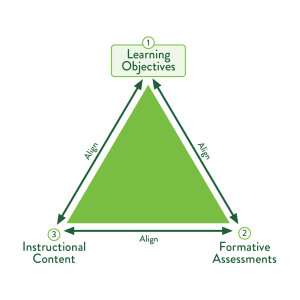10 What Does “Measurable” Mean?
Measurable Learning Objectives
As you design your course, you need to provide learning objectives, or actionable goals that your students should be able to accomplish by the end of a lesson or module. Those learning objectives should be both measurable and well-written. Measurable learning objectives make learning goals clear for students, establish how students will be assessed, and guide instructors as they consider how to present content. Well-written learning objectives make designing instruction easier.

One crucial element to a good learning objective is making the objective measurable. A good learning objective should make it clear to the student what they will need to do to demonstrate mastery of that learning objective.
But what does measurable mean?
A measurable learning objective describes what students should know or be able to do at the end of a module. It is an action that can be measured. A well-defined learning objective has three parts:
- A statement of time
- A measurable verb
- An object or task
Example
By the end of this module, students will be able to do the following:
- Plant a garden container following the planting process
- Choose a location for container placement based on plant/vegetable light requirements
In the example above, you can see all three parts of a well-defined learning objective:
- A statement of time: “By the end of this module”
- Measurable verbs: “Plant” and “Choose”
- Objects or tasks: “…a garden container following the planting process” and “…a location for container placement based on plant/vegetable light requirements”
Measurable Verbs
But what exactly is a “measurable verb”?
A measurable verb is one that is observable. Thus, a measurable learning objective should state what observable things a student should be able to do by the end of a given module. In the example above, for instance, you can observe whether or not a student has planted a garden container according to the planting process or whether or not they have chosen a location for the planter based on the correct light requirements. The more explicit and clear your expectation is, the better student performance will be.
Action verbs tend to be observable, while non-action verbs are not observable, making it difficult to accurately measure objectives that use them.
Examples
Let’s go over a few examples of verbs that aren’t measurable and some better, more measurable verbs you could use instead.
- “Know,” for instance, is rather vague. What kind of knowledge do you want students to obtain? Recall vocabulary in an article or critique an article?
- Recall and critique are more precise and therefore more measurable in comparison to just “knowledge.”
- “Appreciate” is another difficult concept to measure. In what way do you want students to appreciate something? Increase their cultural experiences or integrate a new cultural experience into their current perspective?
- Both increase and integrate are more measurable than appreciate because you can compare where the started with what they gained.
Now, let’s take a more in-depth look at another verb that isn’t very measurable and some questions you can ask yourself to help refine your objective into something more measurable. Say that you want the students to be able to “understand” a concept in your course. How will you measure their understanding?
- How will you know when “understanding” is mastered?
- Will learners demonstrate learning / understanding by being able to explain in writing? By defining concepts? By designing a presentation?
- What is the measurable skill you want them to develop and how will you view and record evidence that the students have mastered that skill?
If you ask yourself these types of questions, it will help you identify which verbs are more measurable and perhaps better pinpoint what it is you want students to do.
Test your knowledge with this interactive.
